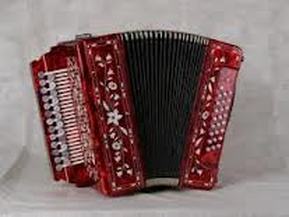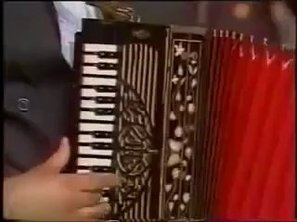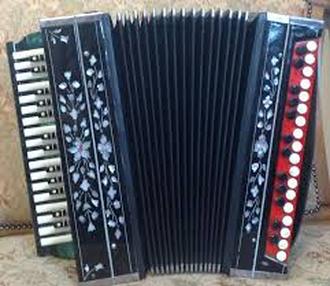The garmon
|
The garmon is a Russian free reed instrument of the same type as an accordeon. Its name comes from the Russian word "garmonika" which means "harmonics". The garmon has two rows of buttons at the right side, which play the notes of a diatonic scale. At the left side a garmon has at least two rows of buttons, which play the primary chord in the key of the instrument as well as its relative harmonic minor key. Many instruments do have additional buttons at the right side with usefull accidental notes.
Some instruments do also have additional buttons at the left hand, for playing in related keys, and a row of free bass buttons, for facilitating the playing of a bass melody. |
There are two major classes of garmons: the unisonoric (plays the same note while pushing or pulling the bellows) and the bisonoric (plays a different note while pushing or pulling the bellows).
Of the unisonoric type are the "livenka" (after Livny, Oryd Oblast) and the "khromka" (chromatic).
Bisonoric garmons are the tula accordeon (after Tula) and the "talyanka" (Italian).
The garmon is usualy played in Caucasian and Volgian folk music.
The standard arrangement of a garmon is known as a "25 x 25" and contains:
The bass keyboard: the principal chords for the major key are in the outer row, placed in circle of fifths order. The principal chords for the harmonic minor key are in the middle row. The free bass notes are in the inner row, including one free accidental bass note.
Of the unisonoric type are the "livenka" (after Livny, Oryd Oblast) and the "khromka" (chromatic).
Bisonoric garmons are the tula accordeon (after Tula) and the "talyanka" (Italian).
The garmon is usualy played in Caucasian and Volgian folk music.
The standard arrangement of a garmon is known as a "25 x 25" and contains:
- 25 treble buttons in two rows: three diatonic octaves and three accidentals
- 25 bass buttons in three rows: two rows of eight buttons, with bass notes and chords, one free bass row.
The bass keyboard: the principal chords for the major key are in the outer row, placed in circle of fifths order. The principal chords for the harmonic minor key are in the middle row. The free bass notes are in the inner row, including one free accidental bass note.
|
During the 19th and 20th century Russian masters invented a lot of different types of local garmons:
|
The tula, vyatka and khromka were the basic instruments for almost all the national Russian and Soviet garmons. But sometimes modifications were needed to fit the local national musical traditions.
|
Volgian
|
|
Oriental accordeon
The oriental bayan was invented in 1936 in the Kazan musical factory. It has a piano keyboard at the right, which is a little smaller. Since 1961 the left keyboard mirrors the right one, though these buttons are not rectangular, but round as the buttons of a button accordeon. This type of instrument is popular in the music of Azerbaijan. Georgian
http://en.wikipedia.org/wiki/Garmon http://anyonemusic.blogspot.be/2008/03/accordions.html http://www.barynya.com/garmoshka.stm |





